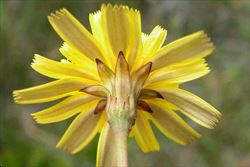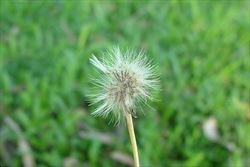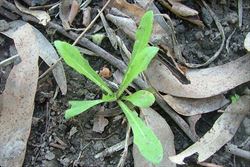Click on images to enlarge

infestation (Photo: Sheldon Navie)

habit (Photo: Sheldon Navie)

habit (Photo: Sheldon Navie)

lobed leaves and slender flowering stem (Photo: Sheldon Navie)

flower-head (Photo: Sheldon Navie)

close-up of underside of flower-head showing floral bracts (Photo: Greg Jordan)

mature seed-head, showing seeds topped with hairs (Photo: Sheldon Navie)

young plant (Photo: Sheldon Navie)
Scientific Name
Leontodon saxatilis Lam.
Synonyms
Hyoseris taraxacoides Vill.
Leontodon leysseri (Wallr.) G. Beck (misapplied)
Leontodon nudicaulis Lowe subsp. taraxacoides (Vill.) Schinz & Thell.
Leontodon hirtus L. (misapplied)
Leontodon taraxacoides (Vill.) Willd. ex Merat
Leontodon taraxacoides (Vill.) Willd. ex Merat subsp. taraxicoides
Family
Asteraceae (Queensland, New South Wales, the ACT, Victoria, Tasmania, Western Australia and the Northern Territory)Compositae (South Australia)
Common Names
autumnal hawkbit, hairy hawkbit, hawkbit, lesser hawkbit, little hawk's-bit, rough hawkbit, rough hawk's-bit, smooth hawkbit
Origin
Native to north-western Africa (i.e. Algeria, Morocco and Tunisia), the Azores, the Madeira Islands, the Canary Islands, Europe (i.e. the UK, Ireland, France, Portugal, Spain, Austria, Belgium, the Czech Republic, Germany, the Netherlands, Poland, Slovakia, Switzerland, Belarus, Albania, Bulgaria, Croatia, Greece, Italy, Romania, Slovenia and Serbia) and western Asia (i.e. Turkey).
Naturalised Distribution
Widely naturalised in southern and eastern Australia. Common in south-eastern Queensland, eastern New South Wales, the ACT, Victoria, Tasmania, south-eastern South Australia and south-western Western Australia. Also present in inland southern Queensland, inland New South Wales and other parts of South Australia.
Notes
Hairy hawkbit (Leontodon saxatilis) is mainly a weed of habitation (e.g. lawns, gardens, footpaths, parks, roadsides, disturbed sites and waste areas), but also invades pastures and natural areas. It is only regarded as an important environmental weed in Victoria, but is a problem species in moist habitats (e.g. swamps, wetlands and riparian areas) in many parts of southern Australia.
In Victoria it is seen as a serious threat to one or more plant communities, and is present in ephemeral grassy wetlands, wet swale herblands, sedge wetlands, peatlands, spring-soak wetlands, riparian woodlands and herb-rich foothill forests. Hairy hawkbit (Leontodon saxatilis) appears on some local and regional environmental weed lists (e.g. in Knox City and the Goulburn Broken Catchment) and has been recorded in numerous conservation areas (e.g. Brisbane Ranges National Park, Mount Mercer Nature Conservation Reserve, Phillip Island Nature Park, Donald MacDonald Reserve, Larcombes Nature Reserve and Blacks Creek Nature Conservation Reserve) in this state.
During a recent study in South Australia, hairy hawkbit (Leontodon saxatilis) was one of the most commonly recorded weed species in wetlands on the Fleurieu Peninsula. It has also been recorded in conservation areas in this state (e.g. in Totness Recreation Park, Coffin Bay National Park, Kaiserstuhl Conservation South Australia Park, Kyeema Conservation Park and Charleston Conservation Park).
Hairy hawkbit (Leontodon saxatilis) is also a common weed of native pastures in Tasmania and is present in some conservation areas in this state too (e.g. Mt Field National Park, Don Reserve and Greens Beach/Kelso Coastal Reserve). It is also growing amongst the only known population of the endangered Tunbridge buttercup (Ranunculus prasinus) in Tasmania, and may be a potential threat to the sirvival of this species. Hairy hawkbit (Leontodon saxatilis ) is also a weed of rocky outcrop vegetation, winter-wet flats, coastal plains and slopes in Western Australia and grasslands and open woodlands in New South Wales.

